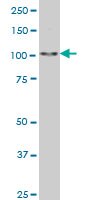DR1052 Sigma-AldrichAnti-SALL4 Mouse mAb (6E3)
This Anti-SALL4 Mouse mAb (6E3) is validated for use in ELISA, Immunoblotting, Paraffin Sections for the detection of SALL4.
More>> This Anti-SALL4 Mouse mAb (6E3) is validated for use in ELISA, Immunoblotting, Paraffin Sections for the detection of SALL4. Less<<Synonymes: Anti-SAL-Like 4
Produits recommandés
Aperçu
| Replacement Information |
|---|
Tableau de caractéristiques principal
| Species Reactivity | Host | Antibody Type |
|---|---|---|
| H, M | M | Monoclonal Antibody |
Prix & Disponibilité
| Référence | Disponibilité | Conditionnement | Qté | Prix | Quantité | |
|---|---|---|---|---|---|---|
| DR1052-100UG |
|
Flacon en verre | 100 μg |
|
— |
| References | |
|---|---|
| References | Cauffman, G., et al. 2009. Hum. Reprod. 24 63. Forte, A., et al. 2009. Mol. Med. 15 392. |
| Product Information | |
|---|---|
| Form | liquid |
| Formulation | In PBS, pH 7.2. |
| Positive control | HeLa cells, NIH3T3 cells, Human testes tissue |
| Preservative | None |
| Quality Level | MQ100 |
| Physicochemical Information |
|---|
| Dimensions |
|---|
| Materials Information |
|---|
| Toxicological Information |
|---|
| Safety Information according to GHS |
|---|
| Safety Information |
|---|
| Product Usage Statements |
|---|
| Packaging Information |
|---|
| Transport Information |
|---|
| Supplemental Information |
|---|
| Specifications |
|---|
| Global Trade Item Number | |
|---|---|
| Référence | GTIN |
| DR1052-100UG | 04055977225983 |
Documentation
Anti-SALL4 Mouse mAb (6E3) FDS
| Titre |
|---|
Anti-SALL4 Mouse mAb (6E3) Certificats d'analyse
| Titre | Numéro de lot |
|---|---|
| DR1052 |
Références bibliographiques
| Aperçu de la référence bibliographique |
|---|
| Cauffman, G., et al. 2009. Hum. Reprod. 24 63. Forte, A., et al. 2009. Mol. Med. 15 392. |














